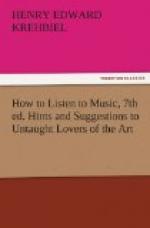“In some still valley in the South, in midsummer. The slate-colored moth on the rock flashes suddenly into crimson and takes wing; the bright lizard darts timorously, and the singing of the grasshopper—”
[Sidenote: Mischievous writing.]
[Sidenote: Musical sensibility and sanity.]
Well, the reader, if he has a liking for such things, may himself go on for quantity. This is intended, I fancy, for poetical hyperbole, but as a matter of fact it is something else, and worse. Mr. Haweis does not hear Ernst’s violin under any such improbable conditions; if he thinks he does he is a proper subject for medical inquiry. Neither does his effort at fine writing help us to appreciate the tone of the instrument. He did not intend that it should, but he probably did intend to make the reader marvel at the exquisite sensibility of his soul to music. This is mischievous, for it tends to make the injudicious think that they are lacking in musical appreciation, unless they, too, can see visions and hear voices and dream fantastic dreams when music is sounding. When such writing is popular it is difficult to make men and women believe that they may be just as susceptible to the influence of music as the child Mozart was to the sound of a trumpet, yet listen to it without once feeling the need of taking leave of their senses or wandering away from sanity. Moreover, when Mr. Haweis says that he sees but does not hear Ernst’s violin more, he speaks most undeserved dispraise of one of the best violin players alive, for Ernst’s violin now belongs to and is played by Lady Halle—she that was Madame Norman-Neruda.
[Sidenote: A place for rhapsody.]
[Sidenote: Intelligent rhapsody.]
Is there, then, no place for rhapsodic writing in musical criticism? Yes, decidedly. It may, indeed, at times be the best, because the truest, writing. One would convey but a sorry idea of a composition were he to confine himself to a technical description of it—the number of its measures, its intervals, modulations, speed, and rhythm. Such a description would only be comprehensible to the trained musician, and to him would picture the body merely, not the soul. One might as well hope to tell of the beauty of a statue by reciting its dimensions. But knowledge as well as sympathy must speak out of the words, so that they may realize Schumann’s lovely conception when he said that the best criticism is that which leaves after it an impression on the reader like that which the music made on the hearer. Read Dr. John Brown’s account of one of Halle’s recitals, reprinted from “The Scotsman,” in the collection of essays entitled “Spare Hours,” if you would see how aptly a sweetly sane mind and a warm heart can rhapsodize without the help of technical knowledge:
[Sidenote: Dr. Brown and Beethoven.]




